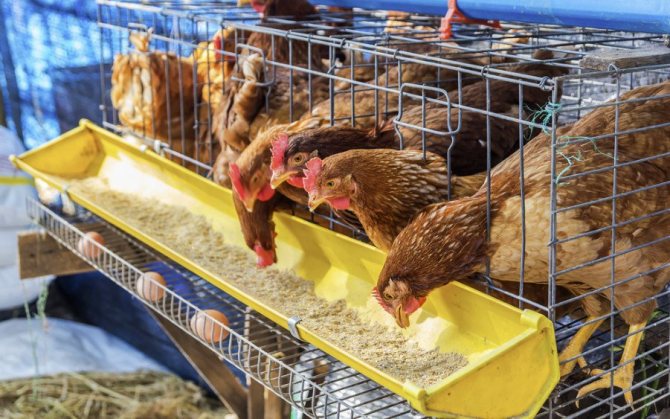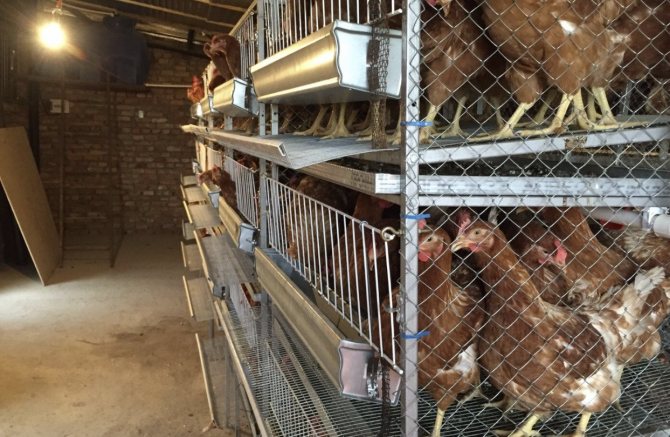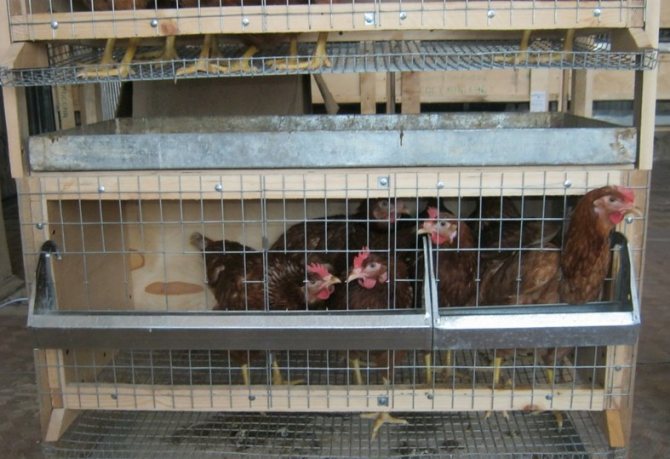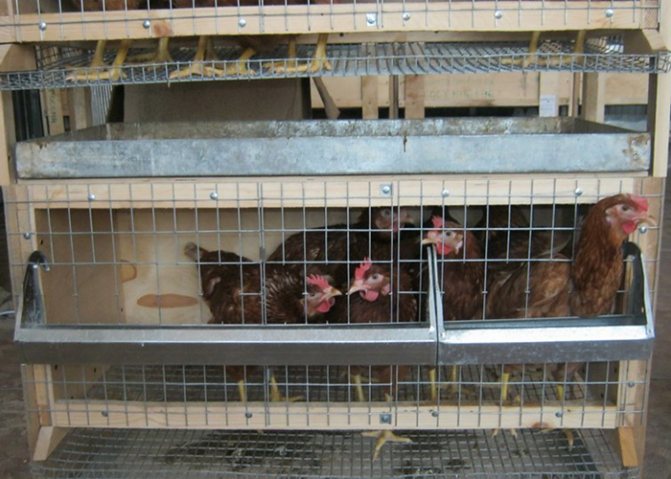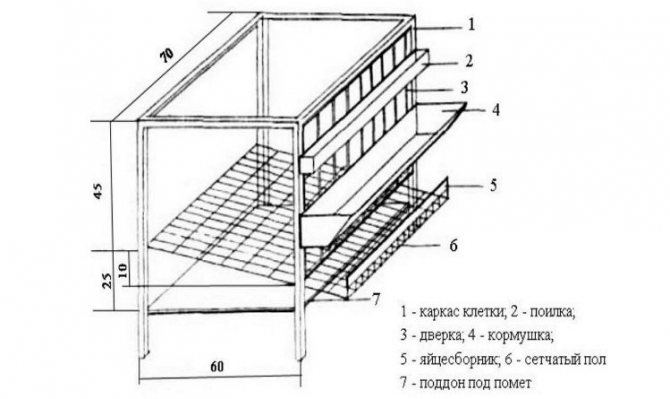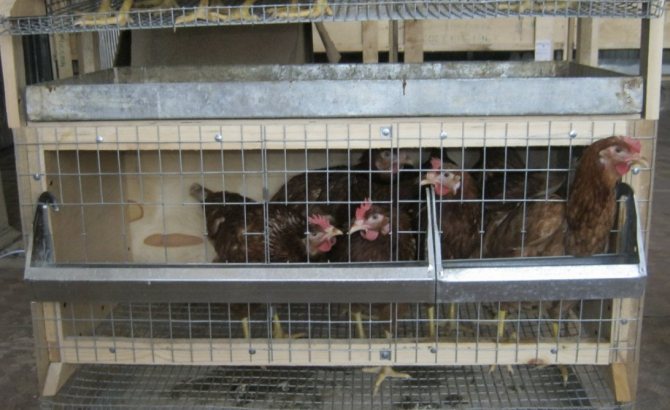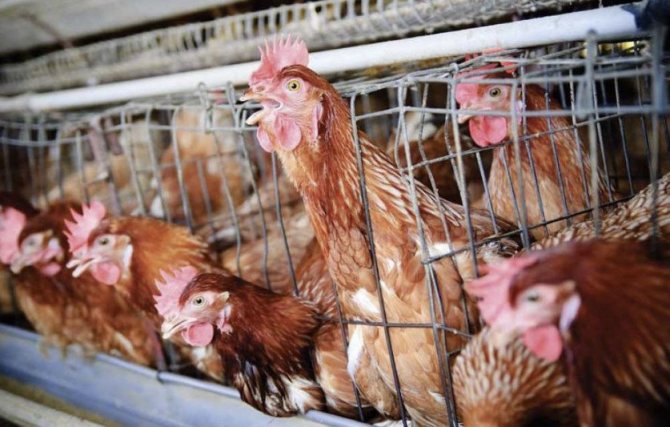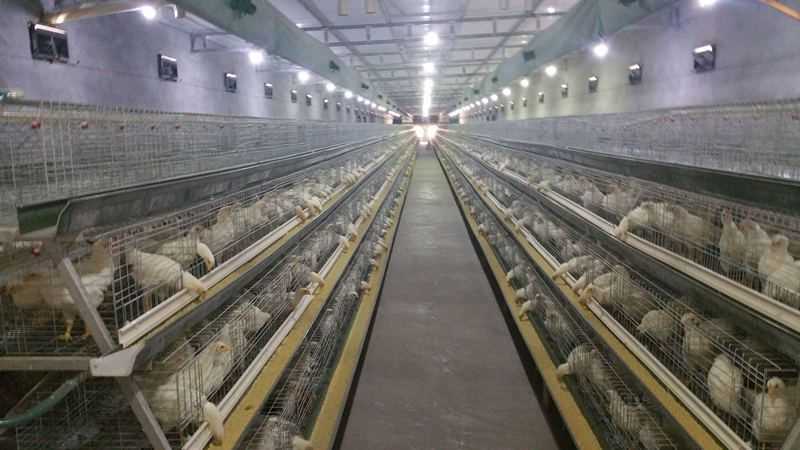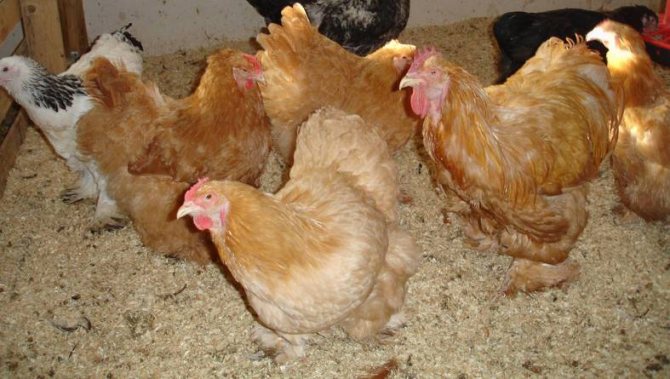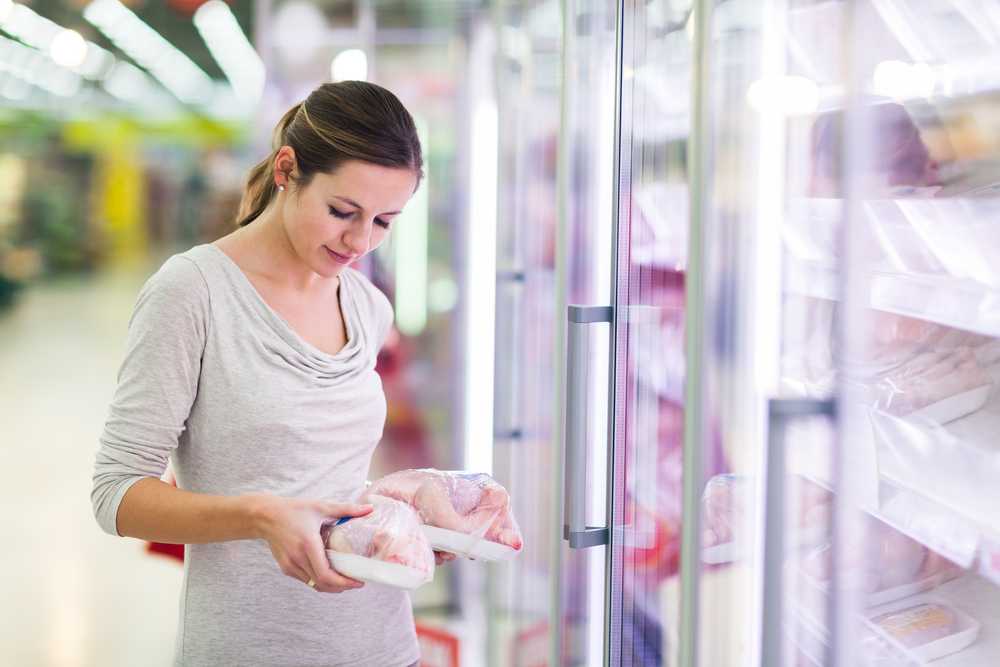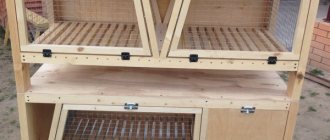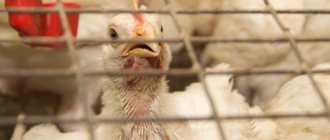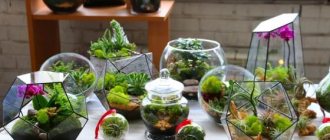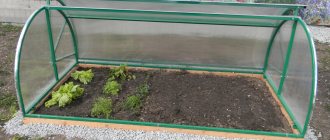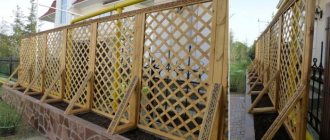Cage breeds
Egg breeds are most suitable for keeping in cages, less often meat chickens are kept in this way. Loman Brown and Leghorn can be called the most popular today, Hisex Brown and Kuchinskaya are less common.
The Loman Brown breed is characterized by high egg production, which does not decrease under conditions of constant presence in the cage - 300-320 eggs per year. At the same time, the eggs are quite large, and the ripening period begins early, already from the age of four months. The period of the most productive egg production lasts about a year and a half, after which there is no need to keep the chicken, as a rule, it is slaughtered. The advantages of this chicken include the fact that almost all the livestock of chicks, as a rule, survives.
Leghorn chickens have also proven themselves well. They perfectly adapt to any living conditions, their performance is high both in free range and in cages. These chickens produce 250 to 300 eggs per year, each weighing about 60 grams. They begin to lay eggs in the fifth month of life, but after a year, productivity decreases.
Hisex Brown continues to sweep intensively for about eighty weeks. She lays up to 350 eggs per year, starting from the fourth month of life, and each egg weighs 70-75 grams. At the same time, the cholesterol content in its eggs is quite low, so this breed of chickens is very appreciated. The Kuchin chicken also adapts well to the cage. Its productivity is not very high - up to 180 eggs per year, but if you create good conditions for it and feed it correctly, the figure can grow to 250 eggs.
Cleaning of cages and poultry houses
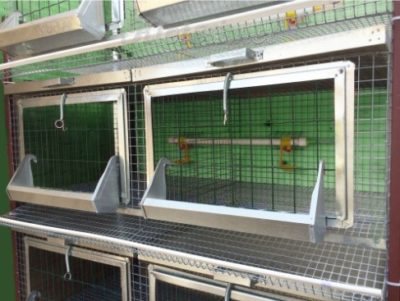
The correct maintenance of laying hens depends on how well the cleanliness of their habitat is maintained. To do this, you need to follow the sanitary and hygienic standards for keeping poultry. Housekeeping should be regular, especially when it comes to cage keeping hens.
To keep the cells clean you need to wipe its rods daily... The feeders are thoroughly washed after feeding the grain. If the chickens are fed green feed or wet mash, then the feeders are cleaned immediately after the end of the chicken meal.
As for the droppings, it falls onto special trays placed under the cages. They are cleaned with special scrapers as they fill. After that, the manure is sent to the workshop for processing, where it becomes a good fertilizer for plants.
You can read more about disinfection and hygiene, as well as how and from what the bedding is organized in chicken coops in separate articles.
Keeping chickens in cages
In order not to reduce the productivity of chickens in the absence of free range, it is important to create favorable conditions for them. The room where the cages are located should be warm, well-ventilated and supplied with electric light. In order for the temperature regime to be observed, it is necessary to raise the cages to a height of one meter above the floor. Air temperature is usually measured at the height of the second tier of cages.
The optimum temperature for chickens is between 20 and 27 degrees Celsius with a relative humidity of 50-70%.For good productivity, the light in the hen house should be on for 17 hours a day. Chicken cages can be equipped independently or purchased from a specialized store. The main thing is that they meet the requirements.
Chicken Cage Requirements:
- dimensions 80 × 50 × 120;
- the presence of a feeder and drinker;
- compartment for collecting eggs;
- compartment for collecting waste products.
The cage is usually a two-tiered structure. Each block can simultaneously contain up to seven chickens. For the convenience of collecting eggs, it is better to equip the cages with a special ramp and an assembly for eggs. To make it easier to clean the cage, it is worth installing a waste collection tray. Collect eggs as often as possible to prevent chickens from pecking at them.
With cage keeping, it is also possible to select eggs for incubation. To do this, use a cage measuring a meter by two, in which ten chickens and a rooster are placed.
In some situations, keeping chickens in a cage is the only option. Cages with chickens can also be found on the balcony of a city apartment. With the right approach, you can get good performance from your birds, while saving space and money on feed. With good care, meat breeds of chickens can also be grown in a cage.
Requirements for the premises for keeping laying hens
In order for the chickens to be healthy and have high productivity, it is necessary to comply with the basic requirements for their maintenance. The first condition is the presence of a chicken coop, which can be a warm shed or any other room made of wood, brick or blocks. The size is determined by the number of chickens and the chosen method of keeping them. It is also important that the laying hens meet the following requirements:
- Correct planting density. The best stocking density for chickens is from 2 to 5 birds per 1 square meter. If chickens are housed too closely, their lives are full of stress and discomfort, leading to illness and decreased performance. If the stocking density is low, a significant area of the chicken coop may be unused.
- Normal air humidity. 60 or 70% is the ideal relative humidity in the chicken coop. If the moisture reading drops below, the mucous membrane of the chicken's respiratory tract dries up, and this leads to inflammation. In addition, dry air causes itchy skin and loss of feathers. On the other hand, high humidity also creates conditions for the development of diseases. If heat is added to high humidity, it causes heatstroke. And in the case when the room is damp and cold, the chickens are supercooled. It is extremely important to provide the chicken coop with adequate ventilation to normalize humidity. A branch pipe installed in a hole in the wall is ideal for this.
Poultry house equipment
It is important to equip the coop with equipment that lends itself well to cleaning and disinfection. These should be:
- Feeders. The bird-friendly design of the feeder plays a very important role. It is important that it does not scatter feed and is easy to clean. Wooden feeders are ideal for dry food, and metal ones for wet mash. You will also need another feeder made of any material for mineral feed.
- Drinking bowls. Cellular maintenance requires built-in water tanks. With floor maintenance, drinkers can be very diverse. When chickens are free-range, an ordinary bowl of water is suitable for drinking. And the best solution for a chicken coop is an automatic or trough drinker.
- Perches are a favorite place to rest and sleep. It is important to place perches at a height of 0.6 to 1 m - all on the same level. The optimal diameter of a bar for making a perch is from 5 to 7 cm. It is important that its edges are rounded.
- Nests are where the laying hens lay their eggs. They should be installed in a darkened part of the room.Nests can be located directly on the floor or at a height of no more than 0.6 m. The required number is determined as follows - 1 nest for 4 or 5 chickens.
- A litter board under the perch to keep the coop floor clean and to collect night droppings.
- Lazy. In order for the chickens to be able to independently go into the corral or on free range, it is necessary to provide the chicken coop with manholes. They should be located at a height of 5 cm from the floor and be no more than 40 x 40 cm in size.


Bird care equipment
For successful bird care, you need to acquire the following inventory:
- jigging cage used for catching sick chickens;
- a trapping cage, which is substituted to the manhole, and on the other side a chicken is driven into it;
- scrapers for cleaning perches, manure boards and floors;
- litter engine;
- garden shovel;
- shovel;
- rake for walking care;
- forks for removing old litter;
- a broom for cleaning the litter;
- box for dead birds and their research;
- box for temporary storage of droppings;
- water dispenser;
- a decontamination mat that disinfects shoes when entering and leaving the poultry house;
- a bucket for cleaning inventory;
- manual sprayer for disinfection;
- hook and net for catching chickens;
- boxes for storing consumable feed stock;
- a tub for storing a 2-day supply of water;
- table scales for measuring the volume of feed;
- trough for mixing wet feed;
- buckets for transferring feed and water;
- wire bucket for collecting eggs.
Laying nests
If all the nests are occupied, the hen will lay the egg directly on the floor, increasing the risk of infection or crushing of the egg. To prevent this from happening, each five chickens need to be provided with one nest.
The optimal height for the location of the nests is 0.5 or 0.6 m from the floor. If the nests are higher, the risk of eggs with meat or blood interspersed increases.
It is best to make nests from plywood or wood. The optimal size of the nest is 30x35x35 cm. The nests should be placed in the form of a cabinet or one or two lines in a place protected from direct sunlight.
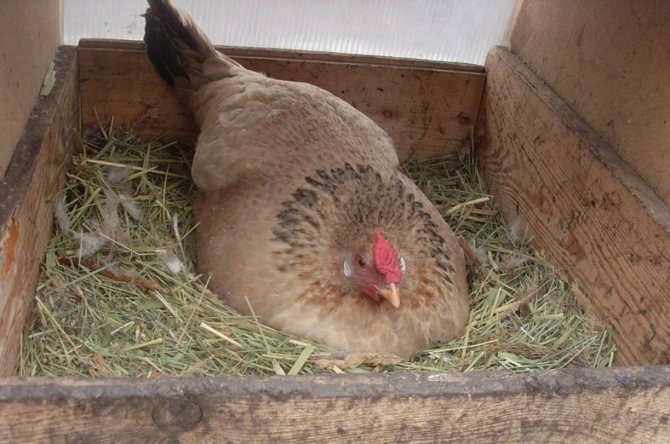

The nests should be filled with soft shavings or straw, which should be renewed as they become dirty. A strap in front of the nest entrance will prevent abrasion of the litter, and a take-off bar will prevent injury. Eggs should be collected from 10:00 to 13:00 every two hours, and more often in winter.
Bird walk
With the walking method of keeping chickens, at least a minimum area for walking is needed - a solarium or an aviary. As a rule, it is equipped on the south side of the poultry house. The area of the yard for walking should be at least half the area of the chicken coop. You can also arrange additional perches in the walking yard.
The enclosure must be fenced off with a galvanized mesh, the height of the fence is from 1.8 to 2 m. A shade canopy must be installed on top of the enclosure. It is highly desirable that a net be stretched over the top of the solarium - this will protect from visits to the enclosure by wild birds that can infect.
If there is an opportunity and desire to provide layers with an unlimited area for walking, a vegetable garden, orchard, berry or vineyard is ideal for these purposes. Chickens not only actively feed themselves during such walks, but also help vegetable gardens and orchards - layers destroy seeds and sprouts of weeds, and also eat worms, larvae and slugs in large quantities. Do not let chickens into the garden only during the period when garden crops sprout to protect young greens. In winter, chickens can be released daily for walking, provided the wind is calm and the temperature is not lower than -15 ° C.
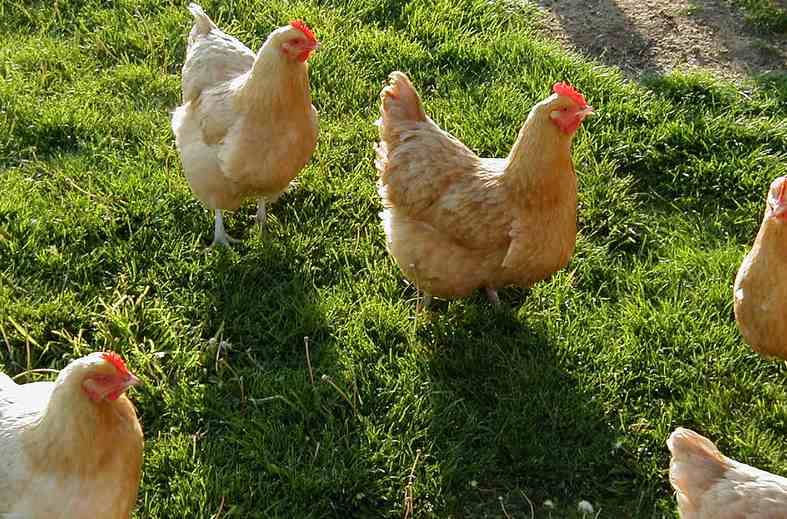

Temperature and light conditions
The most important conditions for keeping laying hens are:
- Comfortable air temperature is from 10 to 20 ° C, but chickens feel best at 12 - 18 ° C.Despite the ability of chickens to survive even at -25 ° C, it is imperative to avoid these extreme conditions. After all, the temperature regime forms the most important thing in the chicken coop - the microclimate. It must be constant and free from sudden changes in temperature that lead to a lack of lay. It is important to remember that lower temperatures lead to higher feed costs for the chickens to warm up. On the other hand, heat leads to a decrease in bird fertility.
- The correct light regime with which you can adjust the egg production of layers. The ideal daylight hours are 12 to 15 hours. In summer, as a rule, there is enough sunlight for birds, and in winter it is necessary to use artificial lighting. If this is not done, too short winter daylight hours will negatively affect the results of chicken "labor". However, you need to use the backlight with great care, keeping in mind the sensitivity of birds to artificial lighting. The light intensity should not exceed 5 watts per 1 square meter of area. It is necessary to increase or decrease daylight hours gradually. You should not increase it to 16 or 17 hours - this will lead to overwork of chickens and a decrease in their fertility.
Features of the cage keeping of chickens
To properly organize the keeping of birds, you need to study the features of their life. One of the main features of domestic chickens is the need for free range. The egg production index directly depends on the physical activity and the duration of the birds' stay in the open air. A courtyard should be built next to the chicken coop and birds should be released periodically into it.
In conditions of cage placement, chickens will not be able to fully reproduce. Since, due to their aggressive nature, it is not recommended to restrict the freedom of the roosters by adding them to the females, it is worth releasing them into the courtyard area at the same time as the laying hens.
When choosing the considered method of keeping birds, you also need to take care of providing basic needs, including ambient temperature, lighting conditions and the availability of air ventilation. When creating conditions, you need to take into account the age of the chickens, since young animals and adults have their own requirements for proper development.
Necessary equipment
The laying of eggs directly depends on several factors:
- good lighting;
- maintaining a stable temperature;
- proper ventilation to supply fresh air;
- balanced diet.
Therefore, heat, LED or energy-saving lamps are installed in the poultry house so that there are no dark areas. For the convenience of adjusting daylight hours (14-16 hours) use a timer. For 1 square meter, there should be 50 watts of an ordinary light bulb or 6 - LED. The latter is much more profitable as it reduces energy costs.
For feeding, bunker-type feeders are installed, and for supplying clean water - automatic drinkers with a vacuum type of supply. And in order for the air to circulate well, there must be electric fans in the chicken coop, which will not allow moisture to collect and become a habitat for fungi.
Advantages and disadvantages
The proliferation of cellular content is due to a large number of positive aspects. The list of main advantages includes the following:
- The ability to breed chickens in a small area or in the same room with cattle.
- Ease of daily care, feeding, waste collection and egg collection.
- Convenient control of the condition of birds, inspection and rejection of unusable individuals due to the fact that the chickens are constantly in the field of view.
- Protection from interaction with wild birds that carry dangerous infectious diseases.
- Savings in feed, achieved through external fixation of the feeder, which eliminates the scattering of food.
- Separation of chicks and adult chickens in different locations.
- Convenience of collecting eggs from special trays, which minimizes the likelihood of pecking and crushing.
In addition to a number of advantages, several negative characteristics can be distinguished. In particular:
- The limited space will restrain the movement of the chickens. Inactivity and occasional outdoor exercise negatively affect productivity.
- To provide all the convenience for birds, you will need to install automatic feeders and drinkers, as well as maintain a certain temperature. This will increase labor and material costs.
- Certain chicken breeds are not genetically inclined to be kept in confined spaces.
- A short exposure to the open sun reduces resistance to disease, which is why the condition of some layers is depressed.
Cell benefits
Cells, and especially cell batteries, have become extremely popular lately. Farmers are looking to lower egg costs and are building multiple floors of cages in their coops.
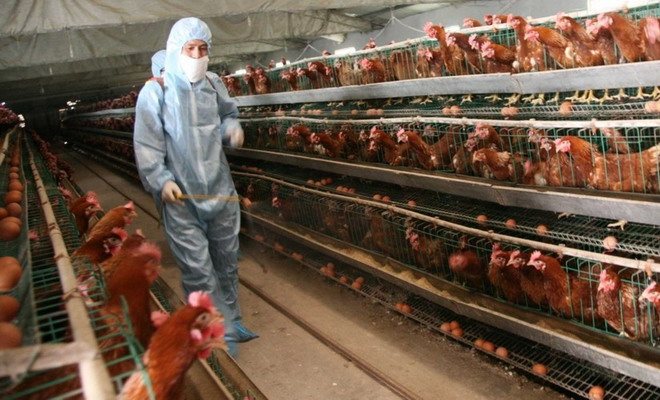

Easy to handle housing and easy bird control
What are the benefits of such content?
- breeding chickens in cages involves placing a large number of heads in a small area;
- the possibility of full mechanization, from light and feeding, ending with the collection of eggs;
- ease of maintenance;
- control over the quality and quantity of feed;
- timely collection of eggs, which excludes the usual losses during walking;
- the ability to create optimal conditions: light, heat and humidity;
- ease of handling cages and poultry;
- difficulty in getting infections, in contrast to outdoor maintenance;
- quick identification of sick birds.
These advantages must be complemented by increased egg production.
How to make a cage with your own hands
To take into account your own requirements for the place of keeping laying hens, you can make a cage yourself. During the construction process, it will be necessary to draw up a drawing indicating the dimensions of the structure, calculate the planting density and provide for the arrangement for the comfortable existence of birds.
Dimensions (edit)
Regardless of the material from which the cage will be made, there are standard dimensions for a four-tier structure. Width is 145 cm, height - 180 cm, depth - 70 cm. The bottom of the cage is made of mesh material with a line diameter of 2.5 mm.
Place a waste collection tray under the base at a distance of 8-10 cm. The front wall is made of a mesh with a thicker diameter than the bottom, and an inlet is cut out.
Stocking density
The number of chickens in one cage depends on the free space inside. In order for the birds to develop and lay eggs correctly, at least 0.2 squares are required for one adult. As a rule, the stocking density does not exceed 5-6 animals per structure.
Procedure for making chicken cages
Cages for chickens are made of a metal lattice and can be fixed in either a metal or a wooden frame. To mount the cages on a metal frame, the following materials will be required:
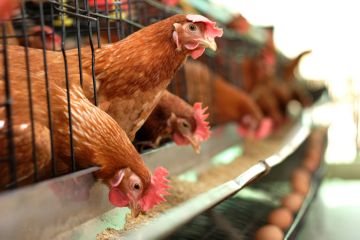

- Fine galvanized mesh with a mesh size of 15-25 mm and a rod thickness of 2.5 mm;
- Wide mesh for the front wall with a cell side of 50 mm;
- Metal corners with a thickness of at least 3 mm;
- Galvanized sheet metal with a thickness of 1.5 mm for the tray;
- Plywood sheets with a thickness of 1.5-2 mm for the trough;
- Water pipe with a diameter of 50-70 mm for drinking bowls;
- Hinges and hooks made of steel;
- Duepel nails or anchor bolts;
- Self-tapping screws for metal and wood.
The litter tray can be made of plastic instead of tin. It is also necessary to prepare a welding machine, a screwdriver, a grinder, a tape measure with a marker for marking the frame and a building level to check the stability of the structure.
Before installation, it is necessary to decide on the size and number of cages, depending on the number of poultry, and make a drawing of the frame in which the cages will be installed.
Below is a drawing of a metal cage for placing four hens of the egg breed or three chickens of the meat-bearing breed:
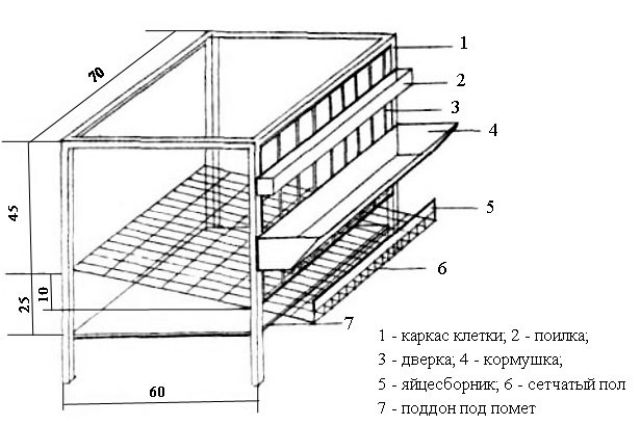

The procedure for assembling the frame and installing the cages is as follows:
- Cut a corner for the frame with a grinder according to the drawing;
- Install vertical frame elements and weld them with horizontal beams;
- Measure the horizontalness of the frame crossbars with a level and, if necessary, correct;
- Strengthen the frame by welding additional diagonal corners with a length of 30-40 mm;
- Cut an inclined egg container from a metal mesh with a grinder and bend its edge, as shown in the drawing;
- Cut out the sidewalls and roofs for the cages;
- Process the front wall of a large lattice, cutting off a number of horizontal cells so that at a height of 15-20 cm from the bottom of the cage, the front lattice has an opening of 50 x 100 mm;
- Assemble the cage from the cut out mesh elements, weld on the fixed parts, and fix the movable front door on the hinges;
- Bend the edges of the galvanized sheet so that their height is 20-40 mm, and the internal dimensions are 600 by 700 mm. Make the required number of trays (by the number of cells);
- Weld to the front of the cage on the sides two metal plates measuring 20 by 30 mm;
- Install the cages on the frame, securing them with metal screws for the lower plates to the horizontal corners of the frame;
- Make a feeder from sheets of thin plywood so that the vertical wall of the feeder adjacent to the cage has a height of 100 mm, the bottom of the feeder protrudes 150 mm, and the rear wall of the feeder has a height of 125 mm;
- Attach metal hooks to the feeder with self-tapping screws and set it at a height of 15-20 cm from the cage pallet;
- For a drinker, cut a plastic pipe lengthwise with a hot knife, install sealed plugs on the sides and fix 7-10 cm above the trough. Supply water to the trough.
The frame can be mounted on wheels for moving around large production facilities or for rolling out the cages into fresh air in the summer. It should be remembered that it is advisable to install the wheels on small frames for 4-6 cells for ease of transportation.
It is important to remember that when installing an inclined floor, the cages of the front wall should not prevent the eggs from rolling into the frontal egg collector.
Sometimes the cage lids are made movable by connecting them with circular hinges to the front doors from above and to the back wall. Such cages are more convenient to maintain and place layers there.
To install the cages on a wooden frame, instead of metal corners, you need to take a square beam of 100 mm for vertical supports and a beam of 40 mm for horizontal beams. A wooden frame is assembled using self-tapping screws with the installation of additional crossbars at an angle of 45 degrees to the supporting beams and fastening these beams with horizontal crossbars.
It is possible to save the installation time of the cages by installing one common inclined floor, screwing the rolled mesh to the crossbars with self-tapping screws with a wide head, and then installing the cages without a floor on top. It should be remembered that there should be one litter tray for no more than two cages, otherwise it will be difficult to clean.
Plants of North America are often striking in their diversity and uniqueness.
The diet of chickens is very different from that of adult chickens. Read about how to feed them properly here.
The broiler shed has its own specific features. You can find out how to build it correctly by reading our article.
How to properly keep chickens
It is necessary to keep laying hens at home taking into account a number of rules.In order for birds to actively develop and maintain a high performance indicator, an integrated approach will need to be provided.
Food
You can feed the birds with ready-made combined feeds that contain all the necessary nutritional components, or with natural products. In the diet of birds, you can include corn grits, grated vegetables, herbs. When using compound feed, pour it into the feeders as it is consumed. Other foods should be given to birds several times a day on a schedule.
Chickens should have clean water in drinking bowls on an ongoing basis.
Cleaning of cages
It is recommended to shake the droppings out of the trays and carry out basic cleaning of the cages daily. The presence of dirt, falling feathers and other waste leads to the spread of parasites and diseases of birds. Once a quarter, you should perform a large-scale cleaning of the entire chicken coop, purify the air and disinfect the room.
Prevention of diseases and parasites
Most chicken diseases and parasite infestations occur due to violation of conditions of detention. As a preventive measure, it is recommended:
- constantly monitor the condition of the birds;
- with slow growth and thinness, increase the content of vitamins in the feed;
- keep the chicken coop clean;
- carry out protective treatment of chickens.
Ventilation
Ventilation in the house helps to bring in fresh air and eliminate unpleasant odors. Typically, ventilation is installed during the construction phase of the chicken coop. In the absence of a hood, it is necessary to regularly ventilate the room in a natural way.
Equipment for arrangement of cages
The feeder and drinker are placed on the front mesh wall. The trough runs along its entire length and at a height of 10-15 cm from the floor. It is important to make sure that there are 8-10 cm of feeders for 1 individual. Usually, feed equipment is made of food grade plastic or galvanized iron.
It is advisable to use a nipple drinker - this is the most convenient option for chickens. On average, one individual needs about 0.5 liters of water per day to quench thirst and normal functioning of the body. For 5 chickens, 1 nipple is required. It is better to pour water into the drinking bowls with settled water.
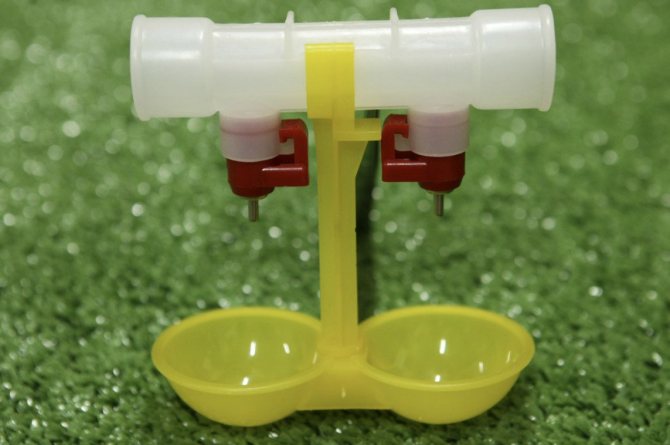

Nipple drinker At a distance of 10–15 cm under the cage, there is a pull-out zinc pan, into which bird excrement, feathers, fluff and other debris will be collected. At the same distance, a trough is equipped for collecting eggs. At its end there is a removable tray - eggs are rolled into it.
Additional tips for beginner poultry farmers
With little experience in keeping chickens, poultry farmers often face common problems. To avoid mistakes, you should familiarize yourself with the recommendations for breeding birds.
Cellular fatigue
As a result of constant presence in confined spaces, some types of chickens may develop cell fatigue syndrome. The consequences of the syndrome are muscle paralysis and osteoporosis. For treatment, the birds are given dietary calcium and the length of time they spend outdoors.
Panic
After placing chickens in a closed cage, they may experience panic, which manifests itself in the form of restless behavior. In this situation, you need to gradually accustom the birds to new conditions so as not to create stress.
Cannibalism
Cannibalism is a pathology of behavior of chickens and consists in an aggressive attitude towards fellows and damage to eggs. To avoid the negative consequences of cannibalism, aggressive individuals should be raised in separate structures.
Broken wings
The collision of birds with various obstacles often leads to the fracture of the wings. It is not recommended to treat fractures on your own, as this process requires special skills. If the wings are broken, you should seek help from your veterinarian.
Rickets
The reason for the development of rickets is an unbalanced diet of birds. The main control measure is to revise the diet.As a result of rickets, the elasticity of the bones can increase and they cannot support the chicken's weight.
Possible problems and solutions
When living in cells, birds most often experience the following health problems: osteoporosis (a disease of the musculoskeletal system), vitamin deficiencies (hypovitaminosis, rickets) and minerals. Let's consider possible problems and ways to solve them:
- Osteoporosis or cell paralysis develops due to a lack of calcium and vitamin D. It is accompanied by impaired bone growth, exhaustion, dehydration. Prevention of this disease consists in strict control of the replenishment of the body with calcium and vitamin D with feed, taking into account the age and productivity of the bird.
- Another disease that often develops in cages in chickens due to a lack of vitamin D is rickets. It is manifested by softening of the beak, claws, chest, weakness, exhaustion, poor appetite. Prevention will consist in the introduction of fish oil, fermented milk products, carrots, bone meal, spinach, shellfish into the feed.
- Lack of vitamin A is manifested by growth retardation, bone deformation, and a drop in productivity. To prevent it, chickens should have greens, carrots, nettles, pumpkin in their diet.
- With a deficiency of B vitamins, problems with the nervous system appear. It is necessary to ensure that there is a sufficient amount of proteins, bran, sprouted grain in the feed of caged birds.
- Incorrectly mounted cages can cause injury to birds and loss of eggs. This problem is solved by installing good cages with proper installation of all equipment.
- Every day, the owner of caged birds should inspect the livestock for health status. If a sick individual is found, it must be immediately quarantined to prevent a massive outbreak of the disease.
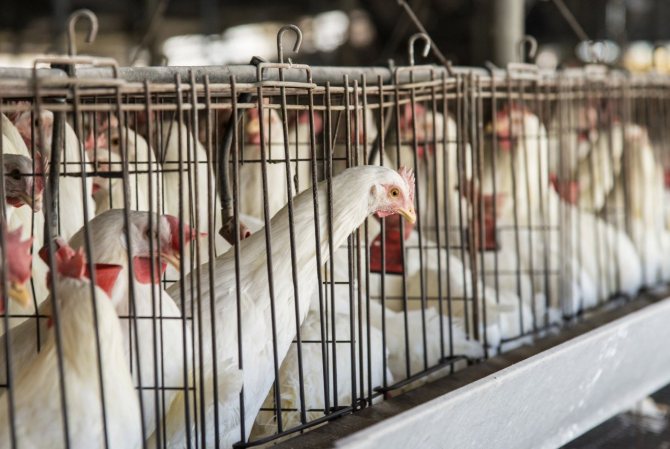

So, chicken cages are widely used today. It has a number of advantages and disadvantages. Suitable for large and medium sized farms. Requires significant initial investment. The cages for the content can be made with your own hands or purchased in a ready-made version.
What breeds of chickens are suitable for cage keeping
The best breeds for cage keeping are rightfully considered:
Kuchinskaya
The main characteristics of the breed:
- medium-sized head;
- long body (convex chest and wide back);
- powerful yellow-brown beak;
- red lobes;
- leafy comb;
- wings that fit tightly to the body;
- low yellow legs;
- gold-calico plumage;
- lush gray down;
- the average weight of females - 2.8 kg, males - 3.8 kg;
- egg weight - 60 g;
- egg color - light brown;
- annual egg production - 180-250 pcs.
Dignity
Placing birds in such structures provides several advantages over traditional boxes or perches. Indeed, in this case, the number of chickens will not be difficult to increase, even though the territory is very limited in its area. It is also possible, even at home, to keep chickens in cages, just because it will be very convenient to serve such a bird. Feed will be saved due to ergonomics in feeding and limited mobility of the birds. It will take much less time to collect eggs. Such conditions provide greater security. And if in traditional chicken coops one square meter is allocated for each bird, here it will accommodate up to 10 layers. And this reduces the cost of maintaining the premises.
You will be interested in: Tomato Blizzard: description, cultivation, care, harvesting
You will be interested in: Breeding chicken at home
The cage keeping of laying hens facilitates the cleaning procedure. In the cages, the bird is more protected from predators and infections that wild animals can bring with them. The feed is dispensed in separate trays, which means that it will not wake up and trample.Also, the bird is inactive, which means that it will not need a lot of feed. Breeds of chickens for cage keeping are meat and egg - after all, the weight of such birds in the cages will gain much more than during life in the nests, even if the same amount of feed is spent on them.
Always in this case, equipment for collecting eggs is installed. This makes collecting them easier. But, of course, this method also has its drawbacks.
The basics of cage keeping chickens
When choosing a cage content, it is worth paying due attention to creating comfortable living conditions for chickens:
- Regular ventilation of the room - air change up to 3 times per hour.
- The presence of electric lighting, working 17 hours a day.
- Maintaining optimal temperature conditions at the level of + 20-25 ° С.
- Room humidity should be within 50–70%.
- The recommended cage size is 0.8 x 0.5 x 1.2 m.
- The presence of a feeder (10 cm per 1 chicken) and a drinker (up to 5 birds per 1 nipple).
- The presence of a gutter (compartment) for collecting eggs.
- The tray should be removable to facilitate the cleaning of the cage.
- The location of the cage is chosen so that the light is evenly distributed inside it.
- The material for the manufacture is wood or metal.
Cellular content of chickens: video
disadvantages
The disadvantages of cellular content include:
- making cages for laying hens with their own hands requires additional time and finance;
- drinking system, maintaining temperature, humidity are very expensive;
- the need for frequent cleaning of droppings;
- arrangement of ventilation;
- electricity costs.
It is necessary to realistically assess the situation and calculate the possible costs. Practice suggests that cage keeping is beneficial in the case when the number of heads is not less than five hundred.
What to feed
The choice of the diet of birds contained in a cage is approached more carefully: not only the indicator of their egg production depends on this, but also their health in general. The correct chicken diet should consist not only of carbohydrates, but also of proteins (10-15%), fats (5-6%), fiber, and minerals. It is recommended to choose specialized friable feed, consisting of wheat, cake, vegetable fats, vitamins and minerals.
In addition, birds should always have clean water in the public domain. The optimal volume for 1 individual is 0.5 l. Since there is no walking for chickens, it is necessary to take care of the presence of greens, vegetables and fruits in their diet. It is worth adding chopped grass, food waste, vegetable peelings and weeds to the compound feed. Adults eat twice a day. Serving size - 120-160 g.
Nutrition of chickens with cage keeping: video
Cage keeping is often used not only by poultry farms, but also by private farmers who are unable to organize a place for walking birds. When creating such conditions for growing chickens, carefully read the requirements for the location of the cage, the density of birds in them and the indoor microclimate. It is also worthwhile to take a responsible approach to the choice of diet: in addition to high-quality compound feed, add greens, vegetables and fruits to the daily menu.
Rules and features of the content
Laying cages are slightly different from meat cages. Their main feature is the presence of an inclined floor, due to which the eggs roll into a special groove. Before proceeding with the direct construction of cages for layers, it is better to evaluate all the pros and cons of this method of keeping at home.
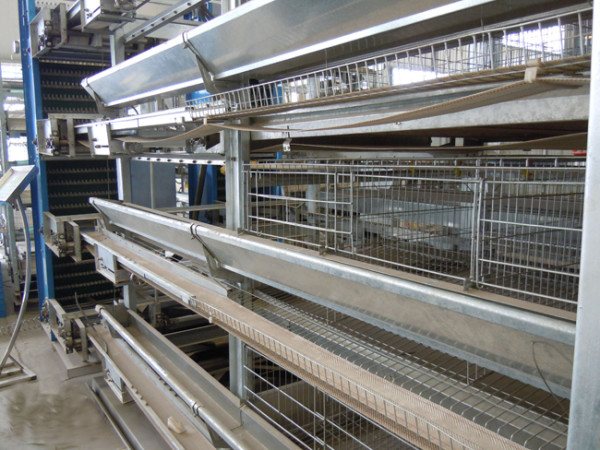

Advantages and disadvantages
| pros | Minuses |
| Greater control of the bird that is always in sight. | Buying or making your own cage. This will require some investment, although the cage quickly pays for itself and, provided that it was made conscientiously, it will last more than one year. |
| Ease of cleaning, because the droppings will be collected in special trays located under the sloping floor of the cage. | In order for the chickens to maintain high egg production and not get sick, they need to provide them with a balanced diet with the addition of minerals, vitamins and probiotics. It's more expensive than feeding them kitchen scraps or homemade food. |
| Convenience of feeding and drinking poultry. As a rule, automatic nipple drinkers are installed for the cages, the likelihood of contamination of which is minimized. Feeders are located outside the cage, most often they are attached to the front of the structure and the chickens do not have the opportunity to row in them, scattering and dirtying food. | The cells must maintain a unique microclimate, including lighting and proper temperature conditions. |
| Possibility of keeping large livestock in a small area. | The cages should be equipped with automatic drinkers, just a container of water will not work for them. |
| Leading an isolated lifestyle, chickens have a lower risk of contracting diseases and infections. | |
| The cage is an additional protection against rodents or other predators that prey on chicken or eggs. | |
| With the cage content, the eggs roll into a special groove, due to which they remain clean and the risk that the chicken will be able to crush or peck the egg is reduced to nothing. |
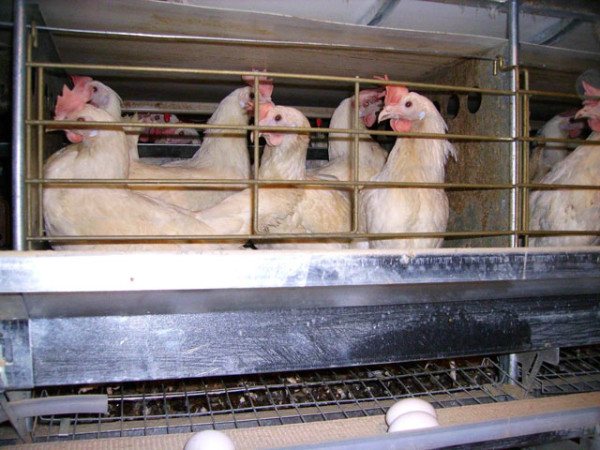

Design
Directly the very structure for planting is a frame that can be made of wooden or metal bars, the walls of the cage are made of fine mesh. You can make all the walls from mesh, or you can make only the front part, and make the rest of the walls from plywood, chipboard or OSB boards.
Feeders and drinkers are mounted to the cage, as well as a groove into which eggs will fall. The floor is made with a slope, and a pallet is placed under it, in which the droppings will accumulate. You can examine the design in detail in the presented photos and videos.
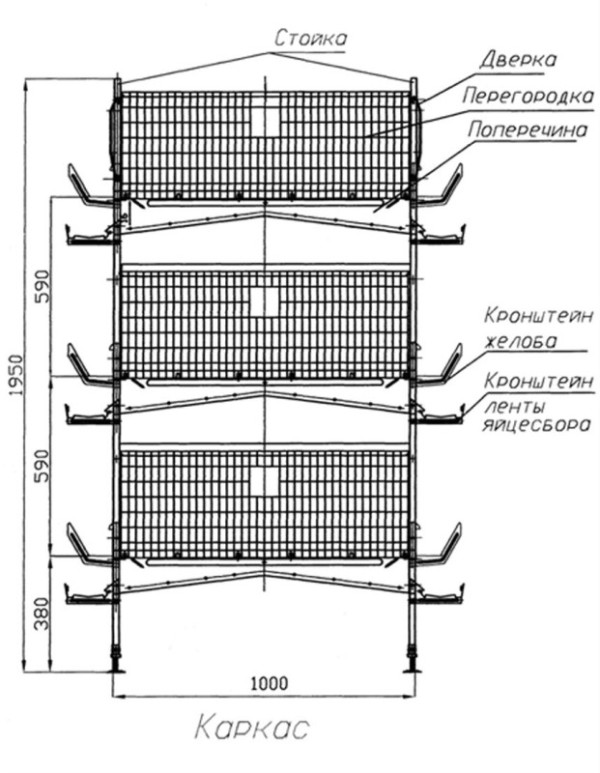

Stocking density
As a rule, chickens of the same age and of the same breed are planted in one closet. This helps to avoid quarrels among birds, because often older individuals "infringe on the rights" of pullets and take away their food and drink. For a comfortable placement, a stocking density of 5-6 individuals per structure is recommended. Do not forget that one hen needs at least 0.1 square meters of area.
If the layers will live with you alone, then they need to be provided with 0.5 square meters of housing. Do not forget that the chicken is an active bird and she loves to walk very much. Therefore, the cellular content is stressful for her, especially if you move the birds that previously lived in the enclosure into the cage.
Illumination
If you choose cage content for your feathered pets at home, then the illumination of such a home will play one of the key roles. The fact is that the length of daylight hours directly affects egg production. In addition, when chickens walk outside and are exposed to natural sunlight, their body generates vitamin D.
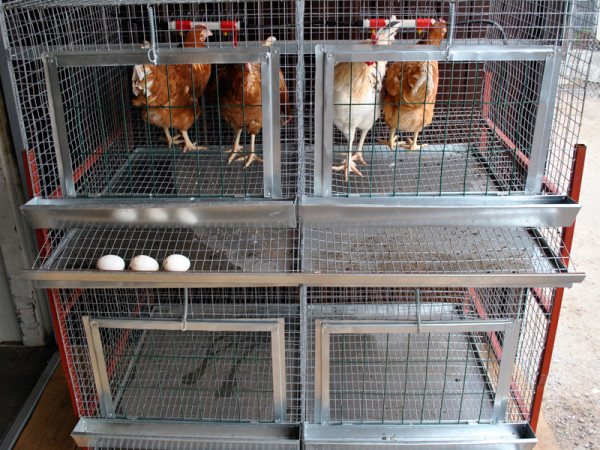

Without sunlight or sufficient artificial light, vitamin D deficiency may occur, which entails rickets, decreased egg production and the development of a number of other diseases. To prevent this from happening, it is necessary to ensure uniform illumination of the chicken coop.
It is undesirable that there are too dark or too light places; try to illuminate the room with the birds evenly. To do this, many breeders install rheostats that automatically adjust the brightness of the light.
Power features
A chicken that is confined to a wire rack and does not have the ability to independently obtain additional food for itself needs a particularly carefully selected diet.Most farmers who choose home cages prefer to feed their chickens with specialized feed for layers. This is really the optimal solution, because kitchen waste for chickens who live in unnatural conditions for themselves is not the best food. The composition of feed for layers must include wheat, sunflower cake, any vegetable fats, calcium carbonate, vitamins and salt.
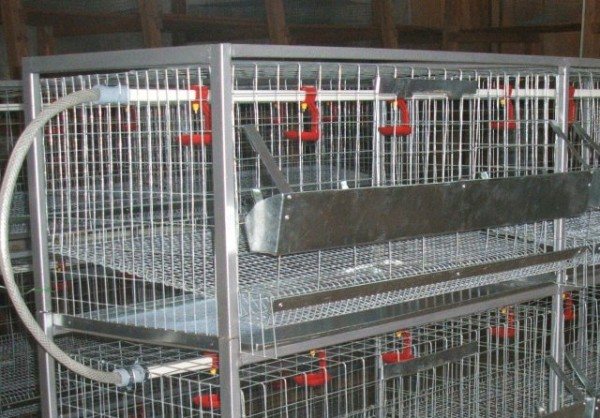

In addition to carbohydrates, the diet of laying hens should contain about 15% protein, 5-6% fat, 6% fiber, minerals and vitamins. Feeding in cage keeping is carried out using automatic feeders. A shell is periodically placed there.
Choosing a cage for a laying hen
In organizing the cultivation and care of animals in a confined space, special attention should be devoted to the issue of buying or making cages. You can find recommendations on how to do this yourself or where to buy it in the article: DIY cages for laying hens.
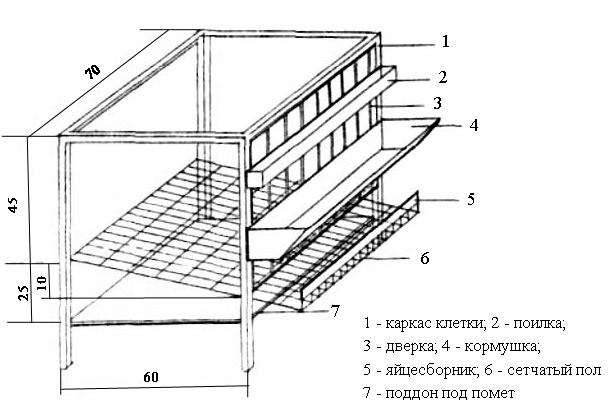

Optimal dimensions

